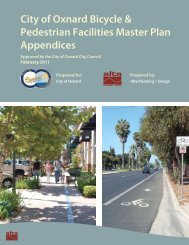View File - Development Services - City of Oxnard
View File - Development Services - City of Oxnard
View File - Development Services - City of Oxnard
You also want an ePaper? Increase the reach of your titles
YUMPU automatically turns print PDFs into web optimized ePapers that Google loves.
WATER RESOURCES TECHNICAL REPORT• Water quality degradation, including seawater intrusion• Ground subsidenceThe hydrogeology and groundwater resources are discussed below, with an emphasis onthe <strong>Oxnard</strong> Plain Forebay, <strong>Oxnard</strong> Plain, and Pleasant Valley basins, which are those basinsthat will be affected by the GREAT Program. Groundwater levels and quality are activelymonitored by the UWCD and USGS, in addition to other entities, as part <strong>of</strong> watermanagement activities. These data are critical to understanding the historical and currentoverdraft conditions. The locations <strong>of</strong> wells from which monitoring data are currentlycollected are summarized on the four maps shown in Figure 2-9, which were providedby UWCD.2.6.1 Aquifer UnitsThe Santa Clara-Calleguas Basin consists <strong>of</strong> multiple aquifers that are grouped into a UASand an LAS. These aquifers contain gravel and sand materials that were deposited along theancestral Santa Clara River, within alluvial fans along the flanks <strong>of</strong> mountains, and withincoastal plain/delta complex at the terminus <strong>of</strong> the ancestral Santa Clara River. The surfacegeology <strong>of</strong> the outcropping stratigraphic units that comprise the UAS, LAS, and deeperbedrock are shown in Figure 2-7, and the stratigraphy <strong>of</strong> the materials comprising theseunits is shown in Figure 2-8.The UAS consists <strong>of</strong> the Shallow, <strong>Oxnard</strong>, and Mugu aquifers, which include theunconsolidated deposits <strong>of</strong> the late Pleistocene and Holocene epochs. The Shallow Aquiferis also referred to as the Semi-Perched Aquifer. The UAS is separated by an unconformityfrom the LAS. The LAS consists <strong>of</strong> the upper and lower Hueneme, Fox Canyon, and GrimesCanyon aquifers, which include the unconsolidated deposits <strong>of</strong> the Pliocene and Pleistoceneepochs. The sediments <strong>of</strong> the LAS extend to about 1,600 feet below sea level in the <strong>Oxnard</strong>Plain. All <strong>of</strong> these aquifers extend <strong>of</strong>fshore within the continental shelf. The onshore part <strong>of</strong>the <strong>Oxnard</strong> Plain is subdivided into a confined region and an unconfined region. Theconfined region includes the <strong>Oxnard</strong> Plain Forebay and the northeastern part <strong>of</strong> the <strong>Oxnard</strong>Plain where the Semi-Perched Aquifer is absent. The sediments <strong>of</strong> the UAS and LAS areunderlain by older bedrock <strong>of</strong> upper Cretaceous and Tertiary age that is consolidated andmostly nonwater bearing.These aquifer systems are bounded below and along mountain fronts by consolidatedbedrock that forms a relatively impermeable boundary to groundwater flow. Numerousfaults act as low permeability boundaries to groundwater flow. The aquifer systems extend<strong>of</strong>fshore where they crop out along the edge <strong>of</strong> the submarine shelf within the coastalsubmarine canyons. Submarine canyons have dissected these regional aquifers, providing ahydraulic connection to the ocean through the submarine outcrops <strong>of</strong> the aquifer system.Regionally, groundwater flows from the inland areas toward the ocean, east to west.Locally, however, overdraft has resulted in groundwater elevations below sea level thathave resulted in flow from the ocean inland (landward flow), which has resulted inseawater intrusion in both UAS and LAS.Three generally east-west cross sections from the USGS groundwater modeling report, B-B’,C-C’, and D-D’, are provided in Figure 2-10 to the subsurface geology <strong>of</strong> these units in the<strong>Oxnard</strong> Plain and Pleasant Valley Areas. The cross sections are aligned with the coastline.W112003002SCO LW1458.DOC/ 033390002 16
















